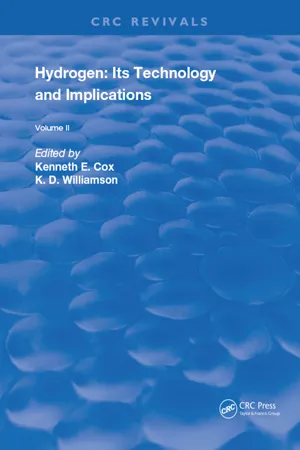![]()
Chapter 1
Transmission of Gaseous Hydrogen
Chapter 1
TRANSMISSION OF GASEOUS HYDROGEN
G. G. Leeth
TABLE OF CONTENTS
1.1 | Introduction |
1.2 | Gas Pipeline |
1.3 | Gas Pipeline Dynamics |
1.4 | Gas Pipeline Costs |
1.5 | Hydrogen Pipeline Analyses |
1.6 | Hydrogen Pipeline Safety |
1.7 | Hydrogen Pipeline Operating Experience |
1.8 | Conclusions |
References |
1.1. INTRODUCTION
During the late 1960s, a major interest in the use of hydrogen arose in the scientific and engineering world community. This interest developed due to the realization that hydrogen possessed many characteristics of the ideal energy vector:
1. It can be produced from water, an inexpensive and plentiful material. When burned, it reverts to water, resulting in a cyclic process which consumes energy but not raw materials.
2. It is a gas under normal conditions and should permit an easy transition from present natural gas and petroleum-fueled energy systems.
Developmental activities in hydrogen energy systems have continued in the 1970s. These have been aided by environmental interests in clean fuels and conservationists’ concerns related to material resource limitations. The “energy crisis” has also spurred continued interest in hydrogen development.
For any hydrogen energy system, pipeline transport of gaseous hydrogen is clearly a major element. This chapter summarizes the present status of hydrogen pipeline knowledge. Technical aspects, cost features, safety considerations, and operating experience are discussed.
1.2. GAS PIPELINES
Bulk transmission of gases is routinely accomplished using pipelines. Approximately 30% of the U.S. energy use in the form of natural gas is moved in a pipeline network. Therefore, it is most convenient to compare hydrogen pipelines with existing natural gas pipelines.
In this chapter, the flow of gas in a pipeline is described in terms of equations based on gas properties. Cost relationships are described basically in terms of pipe size and pumping power requirements. A pipeline design and the cost for a specified energy flow must be calculated. By iteration, a minimum cost design can be determined.
The most difficult relationships to obtain and validate are the costing algorithms. There are two major reasons for this difficulty. First, actual pipeline system costs depend strongly on terrain difficulty and other factors associated with geography. Second, all real pipelines are not optimized for a specific flow, but are designed to permit capacity increases by addition of more and/or larger compressors.
In general, calculations based on an optimum (minimum cost) pipeline system appear to be satisfactory for comparison between gases under varying conditions. The gas flow relationships are correct, but the costing algorithms are true only for some nominal conditions. Consequently, relative comparisons are meaningful, but absolute costs should be carefully evaluated.
1.3. GAS PIPELINE DYNAMICS
Isothermal flow of a compressible fluid is used as a basis for practically all pipeline analyses by the gas industry. Various formulations have been devised to simplify calculations or answer specific questions. The parameters of interest usually include energy flow, pipe diameter, distance between compressor stations, pressure ratio, and compressor horsepower.
Two recent analyses of hydrogen pipelines1,2 use somewhat different formulations of the gas flow equations. Reference 2 also uses European cost data. The general conclusions of both references are the same, although detailed comparisons are difficult. Results of the two methods of calculation are shown in Section 1.5. A brief description of the procedure followed in Reference 1 is given in the following pages as it is probably more useful to American readers.
Equations 1.1 to 1.3 describe the gas flow relationships in terms of the parameters previously mentioned. Equations 1.4 to 1.6 provide the additional relationships needed to solve the set of Equations 1.1 to 1.3. All of the information in these equations is fairly standard fluid dynamics. For further details, see References 3 and 4.
| (1.2) |
| (1.3) |
| (1.4) |
| (1.6) |
where Q = energy fl...
